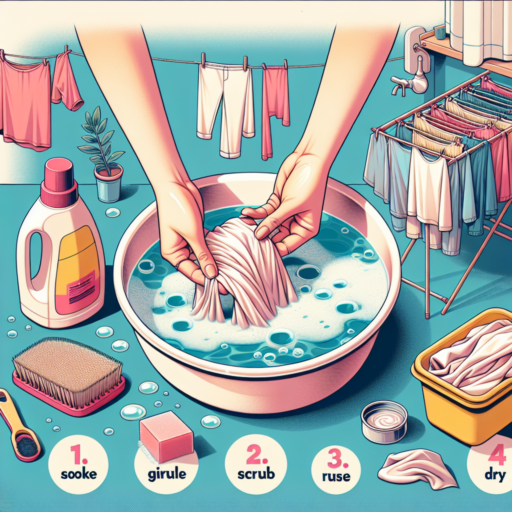Introduction to Washing Nylon Fabrics
Washing nylon fabrics requires a blend of gentle care and specific techniques to maintain their durability and texture. As a synthetic polymer, nylon is known for its strength, elasticity, and resistance to mildew and abrasions. However, when it comes to cleaning these fabrics, understanding the right approach is essential to keep your nylon garments and items looking their best.
Nylon’s resilience makes it a popular choice for a wide range of products, from clothing and lingerie to outdoor gear and home furnishings. Despite its durability, nylon still needs a careful cleaning process to avoid damage. The key is to use mild detergents and avoid high temperatures, which can alter the fabric’s appearance and feel.
When washing nylon, it’s important to separate your laundry, ensuring that nylon fabrics are washed with similar soft fabrics to prevent rough treatment during the machine or hand washing process. For machine washing, selecting a gentle cycle with cold water is advised to protect the fabric’s integrity. Alternatively, hand washing with a soft detergent in lukewarm water can be an excellent method to gently cleanse nylon items without risking damage.
Basic Steps for Washing Nylon at Home
Washing nylon fabrics at home is a straightforward process that can help maintain the integrity and appearance of your clothing. Nylon, known for its durability and resilience, still requires a gentle touch to keep it looking its best. Whether you’re dealing with nylon blend garments or pure nylon items, these fundamental steps will guide you through the best practices for keeping them clean and vibrant.
Preparation Before Washing
Before immersing your nylon garments in water, it’s vital to prepare them properly. Start by turning the items inside out to protect any embellishments and reduce pilling. Check the care label for any specific instructions related to water temperature or recommended washing cycle. It’s also advisable to separate colors to prevent any dye transfer. Pre-treating stains with a gentle detergent can also go a long way in ensuring a thorough clean.
Choosing the Right Detergent and Washing Cycle
When washing nylon, selecting a mild detergent is crucial to prevent damage to the fabric’s fibers. Harsh chemicals can break down nylon, leading to a loss of elasticity and sheen. Opt for a detergent formulated for delicate materials, and consider using a mesh laundry bag for extra protection, especially for lingerie or fine knit items. For the washing cycle, choose a gentle, cold water cycle to minimize the risk of shrinking and fading. The gentle agitation will clean your nylon without compromising its integrity.
Drying Nylon Garments
After washing, the best way to dry nylon items is by air drying. Avoid wringing out your nylon garments, as this can cause them to lose their shape. Instead, gently squeeze out excess water and lay the items flat on a clean towel to dry. If you must use a dryer, choose the lowest heat setting and remove the items while they are still slightly damp to prevent overheating. This method helps preserve the fabric’s elasticity and ensures your nylon garments remain in top condition.
Machine Washing Vs. Hand Washing Nylon: What’s Best?
Deciding the best method for washing nylon fabrics can be a bit of a conundrum for many. Nylon, known for its durability and flexibility, is a common material in clothing and other textiles. However, the debate between machine washing and hand washing nylon is ongoing. Understanding the nuances of each method can help preserve the quality and extend the lifespan of your nylon items.
Considerations for Machine Washing Nylon
Machine washing is a convenient option for many, especially in today’s fast-paced world. When it comes to nylon, machine washing could be suitable if done properly. Use a gentle cycle with cold water to avoid damaging the fibers. Additionally, placing nylon items in a mesh laundry bag can prevent them from snagging or getting stretched during the cycle. However, it’s crucial to avoid high temperatures as they can cause the nylon to lose its shape and elasticity.
The Advantages of Hand Washing Nylon
On the other hand, hand washing nylon offers a gentle alternative that can be more controlled. This method allows for minimal stress on the material, maintaining its integrity over time. Using a mild detergent and lukewarm water, gently agitate the fabric to clean it without subjecting it to harsh mechanical forces. Hand washing is particularly recommended for delicate nylon items like lingerie or sheer fabrics, where retaining the material’s original condition is paramount.
Important Do’s and Don’ts When Washing Nylon
When it comes to maintaining the quality and longevity of nylon fabrics, understanding the proper care techniques is essential. Nylon, known for its durability and resistance to wrinkles, still requires a gentle touch to keep it looking its best. Paying attention to a few key do’s and don’ts can prevent damage and prolong the life of your nylon garments.
Do’s of Washing Nylon
- Use Cold Water: Always opt for cold water when washing nylon items to prevent shrinking and maintain the fabric’s integrity.
- Gentle Cycle: Choose the gentle cycle on your washing machine to avoid stressing the fibers of your nylon garments.
- Use Mild Detergent: A mild detergent is less likely to strip the fabric of its color and protective coatings.
Don’ts of Washing Nylon
- Avoid High Heat: Never use hot water or high heat settings in the dryer as this can cause the nylon to warp or shrink.
- Steer Clear of Bleach: Bleach and other harsh chemicals can damage nylon fibers, leading to wear and tear over time.
- Skip the Iron: Applying high heat directly with an iron can melt or distort nylon fabrics. If you must remove wrinkles, use a steamer at a safe distance.
By adhering to these simple do’s and don’ts, you can keep your nylon garments in pristine condition, wash after wash. Remembering these tips will ensure that your nylon stays as vibrant and resilient as the day you bought it.
Choosing the Right Detergent for Your Nylon Items
When it comes to washing nylon items, selecting the appropriate detergent is crucial to maintain their appearance and longevity. Nylon, known for its durability and elasticity, requires gentle care to ensure it remains in excellent condition. The key is to opt for detergents that can clean effectively without damaging the fabric’s unique qualities.
Factors to Consider
- Type of Detergent: Mild detergents are recommended for nylon fabrics. These detergents are less likely to contain harsh chemicals that can break down the fibers, leading to wear and tear over time.
- Water Temperature: The temperature of the water plays an integral role in the effectiveness of the detergent. For nylon items, cold to lukewarm water is ideal, as high temperatures can cause shrinking and fading.
- Specialty Detergents: Look for detergents formulated for synthetic fabrics like nylon. These specialized products are designed to care for the unique needs of synthetics, offering an added layer of protection.
Understanding the right detergent for your nylon items can significantly impact their care and preservation. By prioritizing mild and specially formulated detergents and paying attention to washing conditions, you can ensure your nylon garments stay vibrant and strong for years to come.
How to Dry Nylon Fabrics to Preserve Their Quality
Drying nylon fabrics properly is essential to preserving their quality and extending their lifespan. Unlike natural fibers, nylon is a synthetic material that reacts differently to heat and tension, making the drying process crucial. Knowing the correct techniques can save you from dealing with shrinkage, loss of elasticity, and texture changes. In this guide, we’ll explore the best practices for drying nylon, ensuring your garments maintain their integrity over time.
Opt for Air Drying When Possible
One of the safest methods to dry nylon fabrics is air drying. Exposing nylon to high temperatures in a dryer can cause the fibers to warp, leading to irreversible damage. Instead, lay the garment flat on a clean, dry towel away from direct sunlight. Direct sunlight can fade the colors of your nylon garments. If you must hang the garment, do so in a shaded area to prevent stretching. This method not only preserves the quality of your nylon fabrics but is also energy-efficient.
Use Low Heat If You Must Use a Dryer
If air drying is not an option and you need to use a dryer, always select the lowest heat setting. High heat can be detrimental to nylon, causing it to shrink or become misshapen. Before starting the cycle, ensure the dryer is free of any items that could snag or pull the nylon fabric, as this could result in tears or stretching. Additionally, consider using a drying bag to protect the nylon from harsh contact with the dryer drum. These precautions will help maintain the fabric’s shape and appearance.
Common Mistakes to Avoid with Nylon Care
Cuidar adecuadamente de las prendas de nylon es esencial para mantener su integridad y prolongar su vida útil. Sin embargo, muchos cometen errores comunes sin darse cuenta de las consecuencias a largo plazo. Desde la forma en que lavamos estas prendas hasta cómo las almacenamos, cada paso cuenta.
Uso Incorrecto de Temperatura de Agua
Una de las equivocaciones más frecuentes es lavar el nylon con temperatura de agua incorrecta. Muchos asumen que el agua caliente es la mejor opción para eliminar manchas, pero esto puede causar que el nylon se encoja o pierda su forma. Al contrario, el uso de agua fría es recomendable, ya que protege las fibras y mantiene el color y la elasticidad de la prenda.
Aplicación de Productos Químicos Dañinos
Otro error común es la aplicación de productos químicos dañinos, como blanqueadores o detergentes fuertes. Estos productos pueden descomponer las fibras de nylon, causando decoloración, pérdida de elasticidad y, finalmente, desgaste prematuro. Para la conservación óptima del nylon, es preferible optar por detergentes suaves y evitar el uso de blanqueadores.
Falta de Protección en el Lavado
Finalmente, muchas personas olvidan proteger sus prendas de nylon durante el proceso de lavado. Sin la protección adecuada, como una bolsa de lavado o seleccionar el ciclo correcto en la lavadora, las prendas pueden torcerse o engancharse con otras, causando daño. Un cuidado cuidadoso y la selección apta del ciclo de lavado pueden evitar estos problemas y garantizar una mayor durabilidad de las prendas de nylon.
Tips for Removing Stains from Nylon Without Damaging It
Removing stains from nylon fabrics can be a delicate process, but with the right technique, you can get your garments, household items, or gear looking pristine without causing any damage. Nylon, known for its durability and elasticity, also requires special care to maintain its quality. Here are some effective tips to tackle stains on nylon without compromising its integrity.
Pre-Treat Stains Promptly
Acting quickly can prevent stains from setting into the nylon fibers, making them easier to remove. Gently blot any excess substance from the surface with a clean, dry cloth. Avoid rubbing the stain, as this can embed it deeper into the fabric. Applying a mild detergent or a specialized stain remover designed for synthetic fabrics directly to the stain before washing can significantly improve the chances of complete removal. Let it sit for a few minutes, but do not allow the solution to dry on the fabric.
Choose the Right Cleaning Agents
When selecting a cleaning agent for nylon, opt for gentle, bleach-free products to avoid discoloration and damage to the fibers. Mild liquid detergents or solutions specifically formulated for synthetic fabrics are ideal. Consider conducting a patch test on a discreet area of the item to ensure that the cleaner does not adversely affect the nylon. Dilute the cleaning agent according to the instructions, rather than applying it full strength, to safeguard the fabric’s integrity.
Wash Carefully
Hand washing is often the safest method for cleaning stained nylon, providing control over the amount of agitation the fabric undergoes. Use lukewarm water and a gentle kneading action to work the cleaning solution into the stain. Rinse thoroughly with cool water to remove all traces of soap or detergent, which can leave a residue if not completely washed away. For machine washing, placing the nylon item in a mesh laundry bag and selecting a gentle cycle can protect it from excessive wear and tear during the process.










